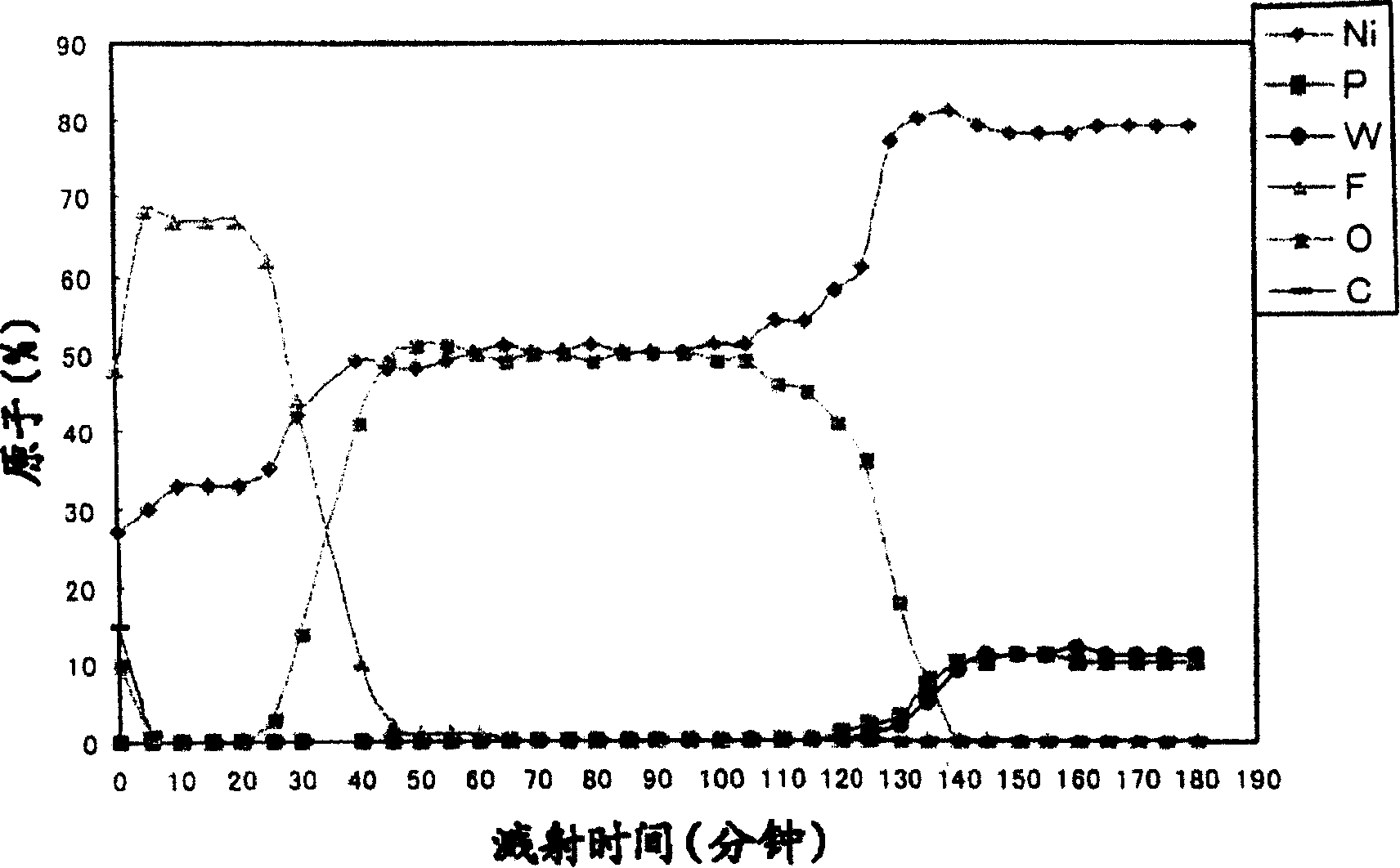Corrosion resistant material, and its production method
A technology of corrosion-resistant materials and manufacturing methods, which is applied in the direction of metal material coating process, coating, superimposed layer plating, etc., can solve the problems of phosphorus fluoride pollution gas, etc., achieve less pollution gas generation, good resistance Excellent wear, durability, and corrosion resistance
- Summary
- Abstract
- Description
- Claims
- Application Information
AI Technical Summary
Problems solved by technology
Method used
Image
Examples
Embodiment 1
[0061] After pickling and pretreatment of the base material stainless steel (SUS316L), dip into the electroless plating bath (composition: nickel sulfate (20g / L), hypophosphorous acid (20g / L), complexing agent (appropriate amount), stabilizer ( Appropriate amount), brightener (appropriate amount), pH 4.5, temperature 90° C.) to make it react for a predetermined time, and a nickel-phosphorus alloy layer is formed on the surface of the stainless steel.
[0062] In the normal-pressure flow-through reaction furnace, the substrate on which the nickel-phosphorus alloy layer has been formed is loaded into the furnace, and after pre-treatment for firing at 200° C. for 1 hour under reduced pressure, the temperature is raised to 500°C.
[0063] Forced oxidation of the nickel-phosphorous alloy layer was then carried out at this temperature for 12 hours. Then, the temperature was lowered while replacing the oxygen in the reaction furnace with nitrogen. Introduce 20% F when the temperatu...
Embodiment 2
[0065] After the stainless steel (SUS316L) of the base material is pickled and pre-treated, it is immersed in an electroless plating bath (composition: nickel sulfate (30g / L), dimethylamino boron (5g / L), complexing agent (appropriate amount), stabilizer (appropriate amount), brightening agent (appropriate amount), pH 7.0, temperature 65°C) for a predetermined time, and a nickel-boron alloy layer was formed on the surface of the stainless steel.
[0066] In the normal-pressure flow-through reaction furnace, the substrate on which the nickel-boron alloy layer has been formed is loaded into the furnace, and after pre-treatment for firing at 200° C. for 1 hour under reduced pressure, the temperature is raised to 500°C.
[0067] Forced oxidation of the nickel-boron alloy layer was then carried out at this temperature for 12 hours. Then, the temperature was lowered while replacing the oxygen in the reaction furnace with nitrogen. Introduce 20% F when the temperature drops to 250°C...
Embodiment 3
[0069] After the stainless steel (SUS316L) of the base material is pickled and pre-treated, it is immersed in an electroless plating bath (composition: nickel sulfate (15g / L), sodium tungstate (20g / L), hypophosphorous acid (20g / L), Mixture (appropriate amount), stabilizer (appropriate amount), brightening agent (appropriate amount), pH9.0, temperature 85 ℃) to make it react for a predetermined time, forming a nickel-phosphorus-tungsten alloy layer on the surface of the stainless steel.
[0070] In an atmospheric pressure flow-through reaction furnace, the substrate on which the nickel-phosphorus-tungsten alloy layer has been formed is loaded into the furnace, and after pre-treatment for firing at 200°C for 1 hour under reduced pressure, oxygen (99.999%) is introduced into the furnace. The temperature was raised to 500°C.
[0071] Forced oxidation of the nickel-phosphorus-tungsten alloy layer was then carried out at this temperature for 12 hours. Then, the temperature was lowe...
PUM
| Property | Measurement | Unit |
|---|---|---|
| thickness | aaaaa | aaaaa |
| thickness | aaaaa | aaaaa |
| thickness | aaaaa | aaaaa |
Abstract
Description
Claims
Application Information
 Login to View More
Login to View More - R&D Engineer
- R&D Manager
- IP Professional
- Industry Leading Data Capabilities
- Powerful AI technology
- Patent DNA Extraction
Browse by: Latest US Patents, China's latest patents, Technical Efficacy Thesaurus, Application Domain, Technology Topic, Popular Technical Reports.
© 2024 PatSnap. All rights reserved.Legal|Privacy policy|Modern Slavery Act Transparency Statement|Sitemap|About US| Contact US: help@patsnap.com










